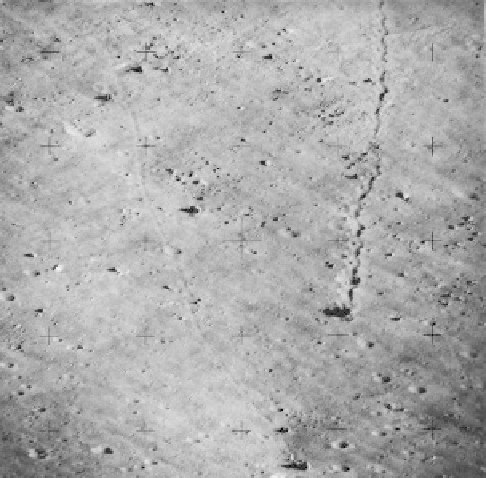Geology Reference
In-Depth Information
Figure 4.44. A view of the Taurus
Littrow valley on the eastern
margin of Mare Serenitatis, showing a bright avalanche deposit that
slid from South Massif across the valley toward North Massif (in the
upper right part of the image). The Apollo 17 astronauts landed in
the cluster of craters east (left) of the landslide; using the lunar rover,
they traversed to the craters at the base of North Massif, across the
valley
floor, and across the landslide deposit to the base of South
Massif. Note the
-
Figure 4.45. This 6 km in diameter impact crater in Mare Cognitum
has been cut by a small mare ridge, showing that a crust had formed
on the mare lavas of suf
cient strength to preserve the crater at the
time of ridge formation (NASA AS 16
-
5429).
that cuts across the mare-
lled
valley and into the highlands, which is indicative of a tectonic origin;
the area shown is about 22 km by 22 km (NASA M-1220).
“
wrinkle ridge
”
a mass of superheated silicate-rich gasses derived from the
mantles of both objects, but with most of the mass of the
Mars-size object being incorporated into the proto-Earth.
Most of the cloud of silicates and ejected debris was
gravitationally bound to Earth and condensed to form
the Moon.
The rapid accretion of material to form the Moon pro-
duced sufficient heat to generate a magma ocean, which
subsequently cooled to form the anorthositic crust seen
today (
Fig. 4.48
). As portrayed by Don Davis and Don
Wilhelms of the US Geological Survey, the Moon con-
tinued to be bombarded by large objects, the records of
which are preserved as impact basins (
Fig. 4.49(a)
). Early
stages of volcanism, represented by some KREEP materi-
als, occurred in this early phase of lunar history. However,
most volcanism occurred during and following the
nal
stages of basin-forming impacts through partial melting of
the lithosphere to generate the mare basalts (
Fig. 4.49(b)
).
With time, the sources for mare volcanism deepened and
eventually magmas were unable to reach the surface, thus
ending volcanic activity by about 2 Ga. Subsequently,
most of the geologic activity on the Moon has been
reduced to minor impact cratering, modest moonquakes
in response to tidal
flexing, and surface modi
cations by
gradation (
Fig. 4.49c
).
Figure 4.46. The Apollo 17 astronauts photographed these tracks
left by boulders that had rolled down the slope of NorthMassif in the
Taurus
Littrow Valley; the boulder on the right is about 5m across
(NASA AS 17
-
-
144
-
21991).





